
See the cards of each species:
Common Eider - Somateria mollissima - Eider à duvet
King Eider - Somateria spectabilis - Eider à tête grise
Spectacled Eider - Somateria fischeri - Eider à lunettes
Steller’s Eider - Polysticta stelleri - Eider de Steller
Text by Nicole Bouglouan
Photographers :
John Anderson
John Anderson Photo Galleries
Steve Garvie
RAINBIRDER Photo galleries & Flickr Rainbirder
Otto Plantema
Trips around the world
Ingo Waschkies
Bird Photography
Nicole Bouglouan
PHOTOGRAPHIC RAMBLE
Sources :
HANDBOOK OF THE BIRDS OF THE WORLD vol 1 by Josep del Hoyo-Andrew Elliot-Jordi Sargatal - Lynx Edicions - ISBN: 8487334105
GUIDE DES CANARDS, DES OIES ET DES CYGNES – de Steve Madge - Delachaux et Niestlé - ISBN: 2603013769
FIELD GUIDE TO THE BIRDS OF NORTH AMERICA - National Geographic Society - ISBN: 0792274512
BirdLife International (BirdLife International)
Alaska Department of Fish and Game – Eiders
Comparative Behavior and Relationships of the Eiders
By Paul A. Johnsgard
Eiders... four really strange ducks
Genus Somateria and Polysticta
The four eiders included in the tribe Mergini, subfamily Anatinae, in the large family Anatidae, are sometimes separated from the other sea ducks and placed in their own tribe Somateriini.
The three eiders of genus Somateria are closely related. These large marine ducks show strong sexual dimorphism with males displaying complex and coloured head pattern and black and white bodies, while females are duller, mostly brown, and fairly similar in all species.
The only member of the genus Polysticta, the Steller’s Eider, is the smallest species. Its head pattern is simpler, but the greenish-black tuft of feathers on the nape gives it an interesting appearance. This one represents probably the link between eiders and other sea ducks.

Eider males typically show black and white pattern and soft-coloured areas on their bodies. But the head pattern is always very distinctive. From the black crown and white face of the Common Eider, through the “spectacles” and the long, sloped forehead of the Spectacled Eider or the conspicuous yellow-orange frontal shield and red bill of the King Eider, to the nuchal greenish-black feather tuft and black collar of the Steller’s Eider, all these peculiar features allow a good identification.
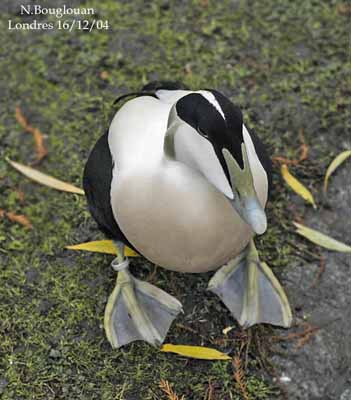
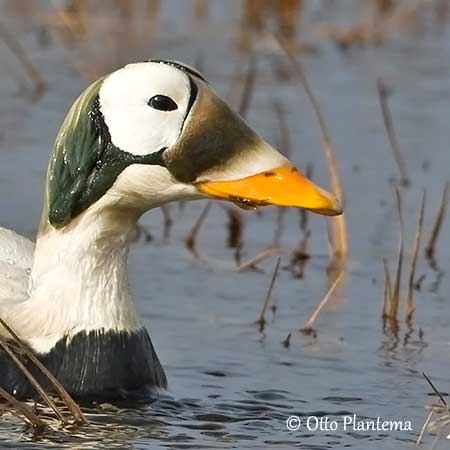
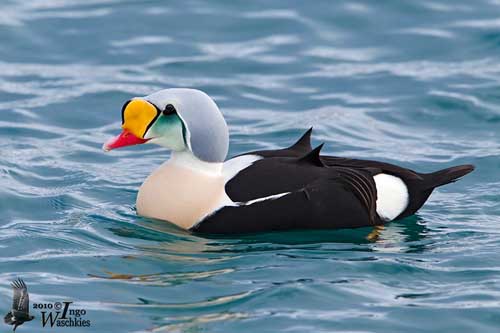
But unlike males, the females have mostly brown, tinged rufous, barred and spotted plumage. The Steller’s Eider female shows some white wingbars on her dark brown plumage, and the Spectacled Eider female shows paler “spectacles” but well-visible. However, they can be identified by size and shape of both body and bill. This cryptic plumage protects them while they are incubating on the ground.
The juveniles are paler than adults, and often resemble females.
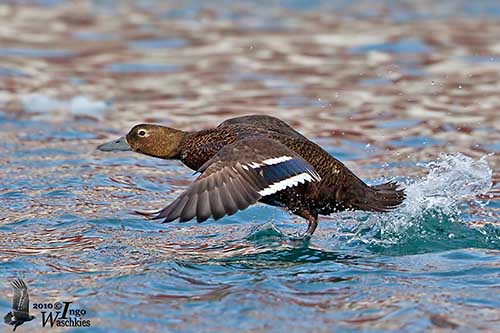
Eiders can be found across Arctic and subarctic regions of the northern hemisphere and all species breed in Alaska and Siberia. Both King Eider and Common Eider have larger breeding range, extending to northern Europe and through Arctic Atlantic. During the breeding season, they frequent the seacoasts and freshwater lakes and rivers of Arctic tundra, usually not far from sea.
During winter, they remain in northern waters, either in bays or river mouths, or at sea in deep waters and away from land, according to the species. Their usual wintering grounds include Northern Europe, Iceland, W Greenland, NE North America, Alaska, Aleutian Islands, Kamchatka, and southern Bering Sea. They return to their breeding grounds when the sea ice starts to break up.
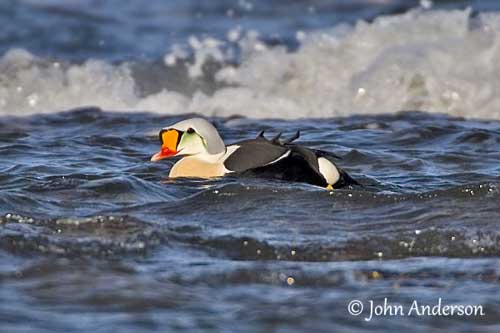
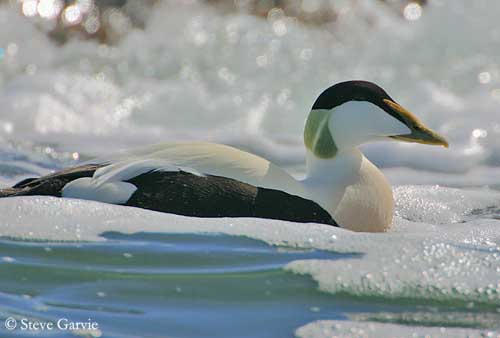
The flight during these migrations is fairly low over the water. The birds fly side by side and form an undulating line just above the waves. Sea ducks are powerful fliers.
At sea or in freshwater lakes or rivers, eiders feeds primarily on molluscs, crustaceans, small fish and various marine invertebrates including worms and echinoderms, and algae too. On Arctic tundra, they feed on leaves, seeds and berries, green parts of plants and other vegetation. Freshwater insects, larvae and arachnids are also taken.
In the water, they feed mainly by diving and head-dipping, and upending in shallow waters. The Spectacled Eider also plucks and dabbles on the water surface.

Femùale with crab
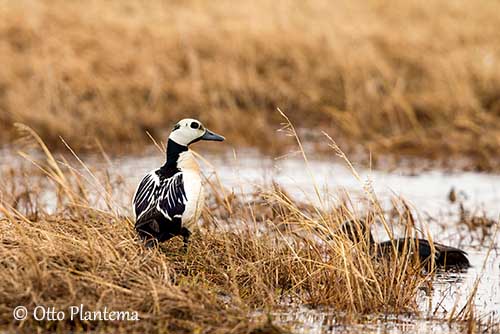
Eiders are gregarious birds and usually live in large flocks all year round, except the Spectacled Eider which occurs in smaller flocks.
The pairs form in late winter or early spring and even during migration, and the nesting period usually begins as soon as they arrive at their breeding grounds. They nest mainly solitary or sometimes in loose colonies on islands or peninsulas in lakes and ponds in tundra. However, the Common Eider breeds in larger colonies along seacoasts, on small islands or on shorelines. The breeding season extends over April, May and June, although the Steller’s Eider nests from late June to August.
The displays are typically similar to those of all the Anatidae. The males perform usual courtship displays including rearing up out of water, wing-flapping, shaking head, stretching neck upwards and jerking head back in quick motion. At this period, the drakes produce various cooing and crooning calls while displaying.
Some fights may occur between males around one female.
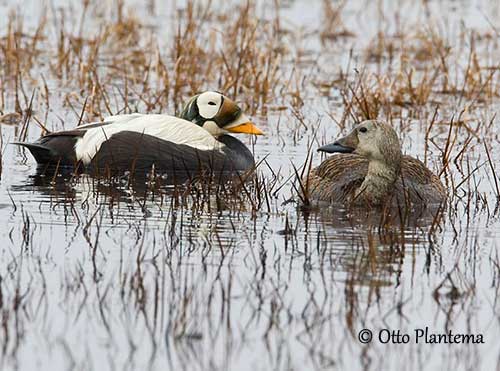
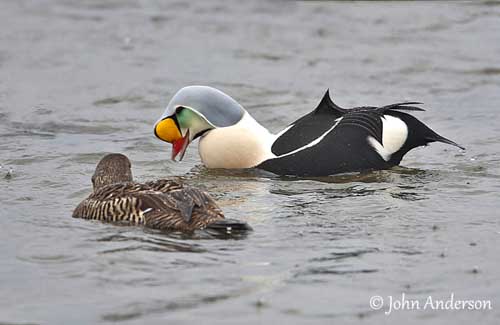
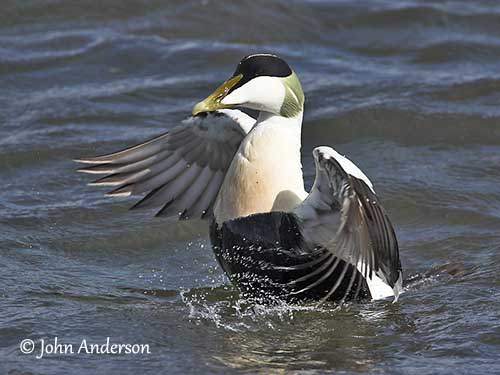
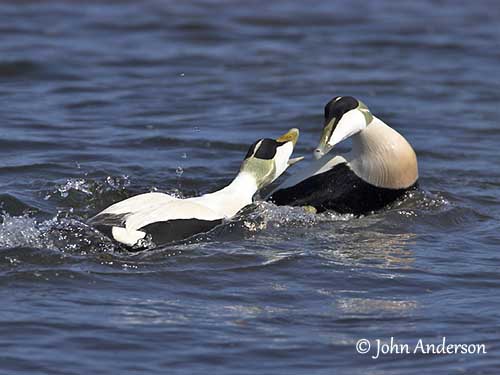
Males fighting
The nest is built by the female, a shallow scrape on the ground made with grasses and lined with down from the female’s breast during the egg laying. The females lay 4-6 eggs, 6-8 in Steller’s Eider. They incubate alone and perform all the nesting duties. The males leave the breeding grounds at the beginning of the incubation, and start the migration in order to gather at distant areas for moulting, before to reach the wintering grounds.
The females incubate during 25-28 days. At hatching, the chicks are precocial and able to walk and feed within one day. They fledge between 50 and 75 days after hatching, depending on the species. They are sexually mature at 2-3 years.
female with ducklings
Females and chicks are threatened by several predators such as gulls, jaegers and foxes, the female during the incubation and the ducklings after hatching while they start to walk and feed.
Both females and young migrate and reach the wintering grounds where they will moult.
Eiders are threatened by oil pollution and lead poisoning as they pick up lead shot from hunting in ponds or lakes. Several predators such as ravens, gulls, jaegers and foxes, and hunting pressure in some areas, involve some declines in populations. The global warming is a problem in the wintering range as it is altering the ecosystem of this area. The ice is replaced by open water, and warmer temperatures reduce the prey’s availability. In the same way, higher temperatures involve the drying of wetlands in the breeding range.
Currently, the Steller’s Eider is listed as Vulnerable, but the three other species are evaluated as Least Concern.
Eiders are powerful marine ducks, somewhat different from other Anatidae. The head pattern of males is sometimes considered ghostly and mysterious, but they are gregarious and beautiful.
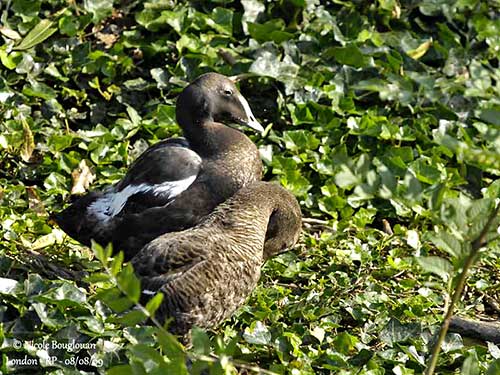
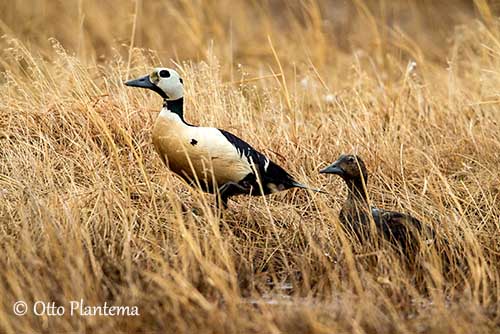
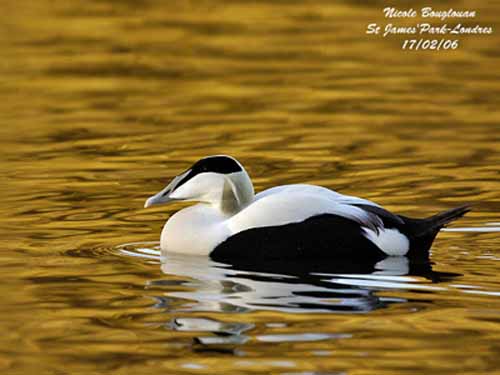
Eclipse plumage